Unit 10 You're supposed to shake hands. Section B(1a—1d) 课件(共13张PPT)
文档属性
| 名称 | Unit 10 You're supposed to shake hands. Section B(1a—1d) 课件(共13张PPT) | 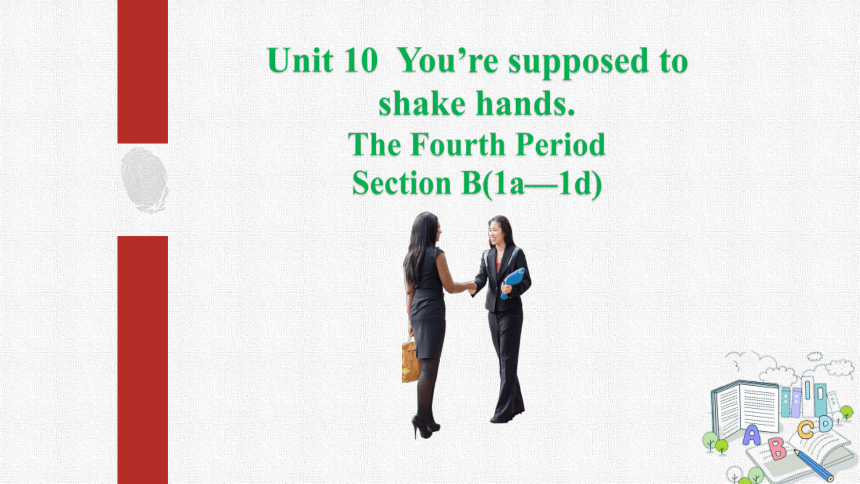 | |
| 格式 | pptx | ||
| 文件大小 | 7.2MB | ||
| 资源类型 | 教案 | ||
| 版本资源 | 人教新目标(Go for it)版 | ||
| 科目 | 英语 | ||
| 更新时间 | 2025-02-08 09:29:58 | ||
图片预览

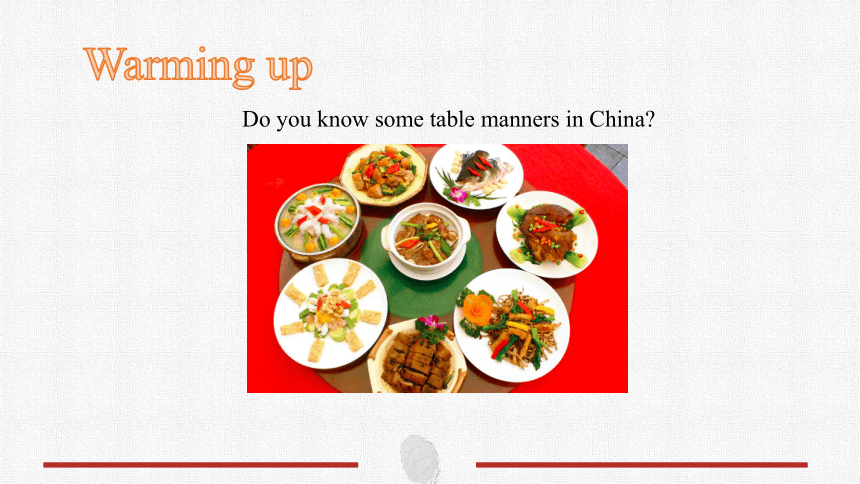
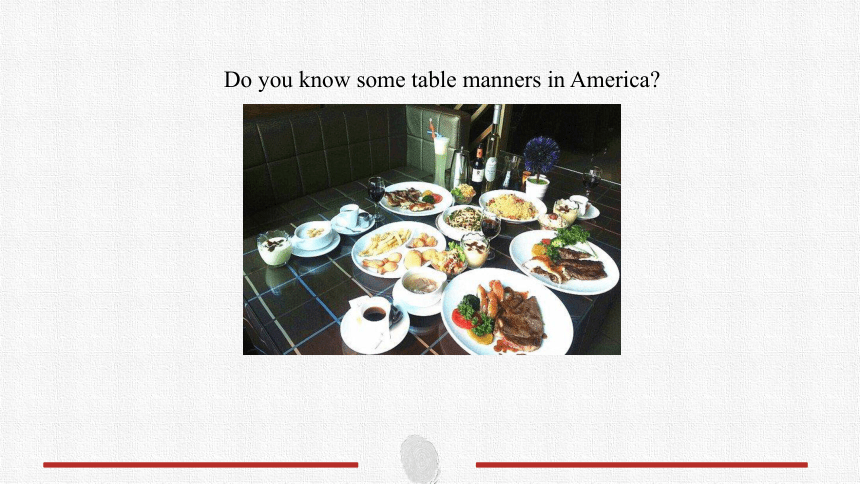
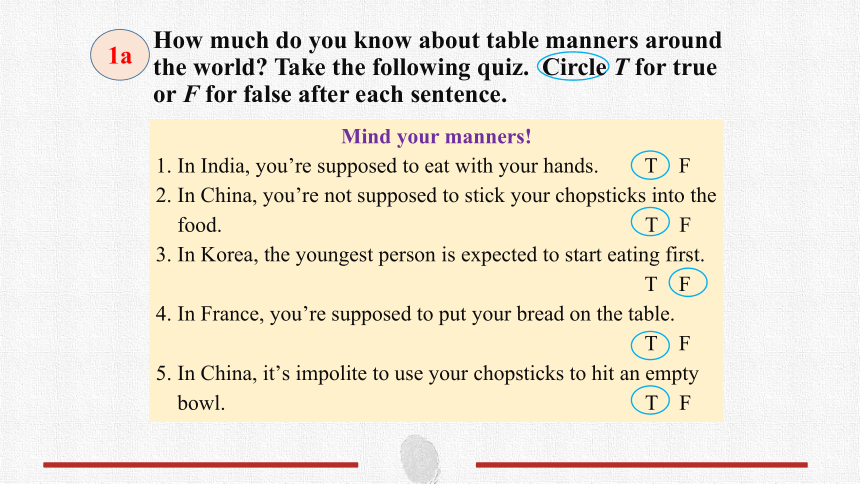
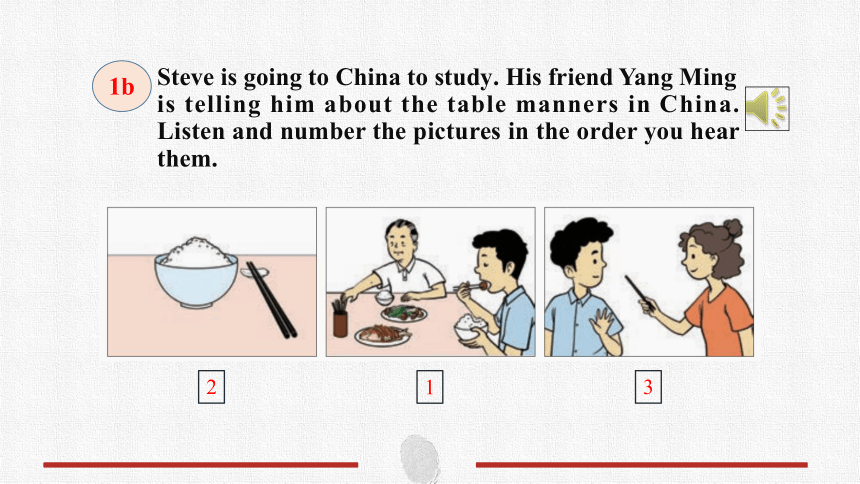

文档简介
(共13张PPT)
Unit 10 You’re supposed to shake hands.
The Fourth Period
Section B(1a—1d)
Do you know some table manners in China
Warming up
Do you know some table manners in America
Mind your manners!
1. In India, you’re supposed to eat with your hands. T F
2. In China, you’re not supposed to stick your chopsticks into the
food. T F
3. In Korea, the youngest person is expected to start eating first.
T F
4. In France, you’re supposed to put your bread on the table.
T F
5. In China, it’s impolite to use your chopsticks to hit an empty
bowl. T F
1a
How much do you know about table manners around the world Take the following quiz. Circle T for true or F for false after each sentence.
2
1
3
Steve is going to China to study. His friend Yang Ming is telling him about the table manners in China. Listen and number the pictures in the order you hear them.
1b
____ 1. You’re not supposed to … a. stick your chopsticks into your food.
____ 2. It’s impolite to … b. point at anyone with your chopsticks.
____ 3. You shouldn’t … c. start eating first if there are older
people at the table.
c
a
b
Listen again. Match these sentence parts.
1c
A: We’re supposed to …
B: Yes, and it’s impolite to …
Talk about other table manners in your country.
1d
e.g.A:We’re supposed to use chopsticks in China.
B:Yes,and it’s impolite to make noise while eating.
1. In China, you’re not supposed to stick your chopsticks into the
food. 在中国,你不应该把筷子插入食物中。(教材第77页)
(1) stick … into … 意为“把……插入……”。
e.g. Don’t stick your fork into your food. 不要把叉子插入食物中。
(2) chopstick 名词,意为“筷子”,常用复数形式。
e.g. We usually eat noodles with chopsticks. 我们通常用筷子吃面条。
Language Points
2. In Korea, the youngest person is expected to start eating first. 在韩国,年龄最小的人应该先开始吃。(教材第77页)
start doing sth. = start to do sth. 意为“开始做某事”。
e.g. He started crying. = He started to cry. 他开始哭起来。
【拓展】作“开始”讲时,start 与 begin 两者可互换,但以下几种情况只能用 start,不能用 begin。
(1) 表示“创办,开设”时。
e.g. He started a new shop last year. 去年他新开了一家商店。
(2) 表示“机器开动”时。
e.g. Can you start the car 你能发动这辆车吗?
(3) 表示“出发,动身”时。
e.g. We must start early. 我们必须早点儿出发。
3. point at anyone with your chopsticks. 用筷子指着任何人。(教材第 77 页)
point at 意为“指着”,侧重所指的对象
point to 意为“指向”,侧重所指的方向
e.g. The teacher is pointing at the blackboard. 老师正指着黑板。
He pointed to the high mountain far away. 他指向远处的高山。
【拓展】point 用作及物动词时,常用于 point sth. at sth.,意为“用……指着……”。
e.g. You shouldn’t point your finger at anyone. 你不应该用手指指着任何人。
4. start eating first if there are older people at the table. 如果有年长的人在餐桌旁时,先开始吃。(教材第77页)
at the table 意为“在餐桌旁”,而 at table 则意为“在吃饭”。
e.g. The man sat at the table and asked for a cup of tea.
那名男子坐在餐桌旁边,要了一杯茶。
根据汉语意思完成句子,每空一词
1. 在美国,你不应该用手拿东西吃。
In the United States, you’re ______ ________ ______ ______
with your hands.
2. 把筷子插到食物里是不礼貌的。
_____ ________ ______ stick your chopsticks into your food.
3. 你的父亲不会为你的错误而生气的。
Your father won’t ________ ________ about your mistake.
4. 你不应该用筷子指着人。
You ________ point ______ anyone ______ your chopsticks.
not
supposed
to
eat
It’s
impolite
to
be
angry
shouldn’t
at
with
Exercise
1. Remember the new words and expressions.
2. Talk about the table manners.
Homework
Unit 10 You’re supposed to shake hands.
The Fourth Period
Section B(1a—1d)
Do you know some table manners in China
Warming up
Do you know some table manners in America
Mind your manners!
1. In India, you’re supposed to eat with your hands. T F
2. In China, you’re not supposed to stick your chopsticks into the
food. T F
3. In Korea, the youngest person is expected to start eating first.
T F
4. In France, you’re supposed to put your bread on the table.
T F
5. In China, it’s impolite to use your chopsticks to hit an empty
bowl. T F
1a
How much do you know about table manners around the world Take the following quiz. Circle T for true or F for false after each sentence.
2
1
3
Steve is going to China to study. His friend Yang Ming is telling him about the table manners in China. Listen and number the pictures in the order you hear them.
1b
____ 1. You’re not supposed to … a. stick your chopsticks into your food.
____ 2. It’s impolite to … b. point at anyone with your chopsticks.
____ 3. You shouldn’t … c. start eating first if there are older
people at the table.
c
a
b
Listen again. Match these sentence parts.
1c
A: We’re supposed to …
B: Yes, and it’s impolite to …
Talk about other table manners in your country.
1d
e.g.A:We’re supposed to use chopsticks in China.
B:Yes,and it’s impolite to make noise while eating.
1. In China, you’re not supposed to stick your chopsticks into the
food. 在中国,你不应该把筷子插入食物中。(教材第77页)
(1) stick … into … 意为“把……插入……”。
e.g. Don’t stick your fork into your food. 不要把叉子插入食物中。
(2) chopstick 名词,意为“筷子”,常用复数形式。
e.g. We usually eat noodles with chopsticks. 我们通常用筷子吃面条。
Language Points
2. In Korea, the youngest person is expected to start eating first. 在韩国,年龄最小的人应该先开始吃。(教材第77页)
start doing sth. = start to do sth. 意为“开始做某事”。
e.g. He started crying. = He started to cry. 他开始哭起来。
【拓展】作“开始”讲时,start 与 begin 两者可互换,但以下几种情况只能用 start,不能用 begin。
(1) 表示“创办,开设”时。
e.g. He started a new shop last year. 去年他新开了一家商店。
(2) 表示“机器开动”时。
e.g. Can you start the car 你能发动这辆车吗?
(3) 表示“出发,动身”时。
e.g. We must start early. 我们必须早点儿出发。
3. point at anyone with your chopsticks. 用筷子指着任何人。(教材第 77 页)
point at 意为“指着”,侧重所指的对象
point to 意为“指向”,侧重所指的方向
e.g. The teacher is pointing at the blackboard. 老师正指着黑板。
He pointed to the high mountain far away. 他指向远处的高山。
【拓展】point 用作及物动词时,常用于 point sth. at sth.,意为“用……指着……”。
e.g. You shouldn’t point your finger at anyone. 你不应该用手指指着任何人。
4. start eating first if there are older people at the table. 如果有年长的人在餐桌旁时,先开始吃。(教材第77页)
at the table 意为“在餐桌旁”,而 at table 则意为“在吃饭”。
e.g. The man sat at the table and asked for a cup of tea.
那名男子坐在餐桌旁边,要了一杯茶。
根据汉语意思完成句子,每空一词
1. 在美国,你不应该用手拿东西吃。
In the United States, you’re ______ ________ ______ ______
with your hands.
2. 把筷子插到食物里是不礼貌的。
_____ ________ ______ stick your chopsticks into your food.
3. 你的父亲不会为你的错误而生气的。
Your father won’t ________ ________ about your mistake.
4. 你不应该用筷子指着人。
You ________ point ______ anyone ______ your chopsticks.
not
supposed
to
eat
It’s
impolite
to
be
angry
shouldn’t
at
with
Exercise
1. Remember the new words and expressions.
2. Talk about the table manners.
Homework
同课章节目录
- Unit 1 How can we become good learners.
- Section A
- Section B
- Unit 2 I think that mooncakes are delicious!
- Section A
- Section B
- Unit 3 Could you please tell me where the restroom
- Section A
- Section B
- Unit 4 I used to be afraid of the dark.
- Section A
- Section B
- Unit 5 What are the shirts made of?
- Section A
- Section B
- Review of Units 1-5
- Unit 6 When was it invented?
- Section A
- Section B
- Unit 7 Teenagers should be allowed to choose their
- Section A
- Section B
- Unit 8 It must belong to Carla.
- Section A
- Section B
- Unit 9 I like music that I can dance to.
- Section A
- Section B
- Unit 10 You're supposed to shake hands.
- Section A
- Section B
- Review of Units 6-10
- Unit 11 Sad movies make me cry.
- Section A
- Section B
- Unit 12 Life is full of the unexpected
- Section A
- Section B
- Unit 13 We're trying to save the earth!
- Section A
- Section B
- Unit 14 I remember meeting all of you in Grade 7.
- Section A
- Section B
- Review of Units 11-14
